The whole of the government’s income tax plan has passed the parliament. So, what does that mean?
The government says their income tax cuts create a fair tax plan that rewards ‘aspiration’ and fights bracket creep. The opposition is telling people that it’s a tax cut for the rich. So what will this income tax cut actually do?
The overall impact:
First, let’s look at who wins from this tax plan. Overall the tax plan favours high income earners. If we split taxpayers into 10 equal groups with the lowest 10% of incomes in the first decile, rising to the highest 10% of income earners in the tenth decile, then most of the benefit (62 per cent) goes to the top 20 per cent of income earners.

Benefit of the whole tax plan by income decile in 2024-25.
This analysis only includes people who have submitted tax returns, so there are a large number of people at the bottom of the income distribution who are on benefits (like the age pension) that are not included. This means that our analysis actually underestimates the amount that will be going to high income earners.
Impacts of stage 1:
The tax plan is split into three stages. Stage 1 comes into effect next month, but don’t get too excited - most of stage 1 is tax refunds, so you won’t actually get any of the tax cut until you submit your tax return in over a year’s time.
Stage 1 actually will put money into the pockets of middle and low income taxpayers. If we look at who wins by decile, we see it is well spread.
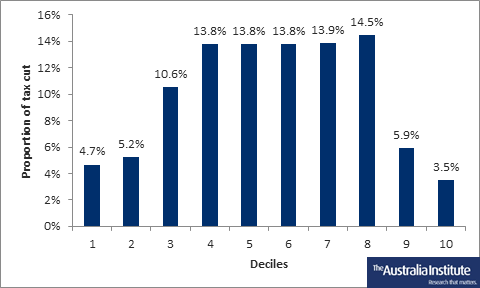
Benefit of stage 1 by income decile in 2018-19
Stage 1 has broad support in the parliament, with the opposition and all of the crossbench supporting it, except the Greens. The more controversial parts are in stage 2 and 3. These stages are what see an overwhelming amount of the benefit flow to our biggest income earners.
Impacts of stages 2 and 3:
Unfortunately, the rest of the income tax plan overwhelmingly benefits high income earners.
In fact the majority of the Senate thinks that stage 3 should be repealed before it comes into effect in 2024-25. The only reason it passed was that some of the crossbench didn’t want to block the stage 1 and 2 tax cuts, so they passed the package as a whole.
If we look at who benefits from stage 3 we see that 95 per cent goes to the top two deciles, while a massive 70 per cent of people get nothing at all.
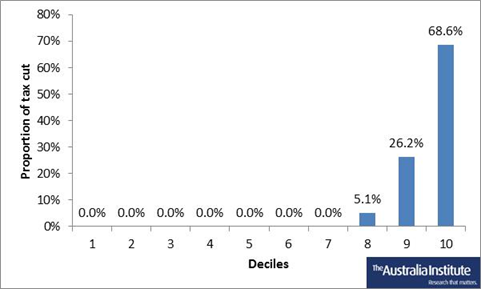
Benefit of stage 3 by income decile in 2024-25
The cost:
After ten years, when the tax cuts are fully in place, they will be costing the budget $24.6 billion per year.
When we divide up the cost of each stage however, Its clear to see how that money is being spent - only 3 per cent ($800 million) will be going to stage 1 while 97 per cent ($23.8 billion) will be spent on stage 2 and 3.
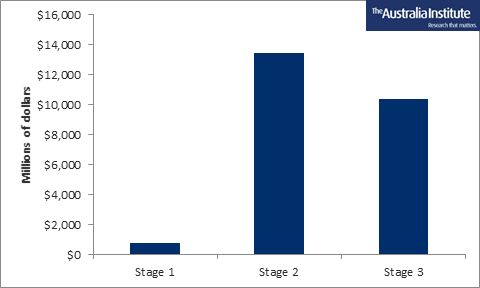
Cost of each stage of the tax cut plan in 2028-29. Source: Parliamentary Budget Office estimate
Who else benefits from the income tax cuts?
The tax cuts don’t just benefit those at the top, they also favour men over women. For every dollar that this tax cut plan gives to women, it will give $2 to men.
This is because the tax cut favours high income earners and most high income earners are men. These tax cuts will increase the post-tax income divide between men and women.
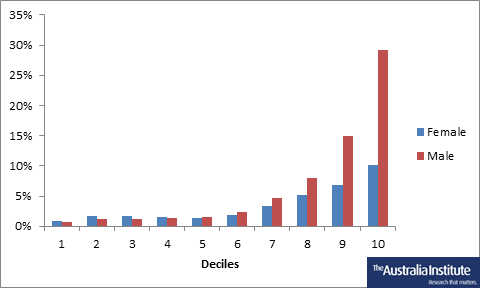
Benefit of tax cut by gender by decile in 2024-25
But high income earners pay most of the tax - Don’t they deserve the biggest tax break?
The government has claimed that looking at the dollar values of high income taxpayers does not offer a fair comparison of the tax cut because high income earners pay more tax. While this is true, the tax cut being offered to high income earners is still larger as a percentage of the amount of tax they pay.
That is to say, high income earners are still getting a bigger tax cut even taking into account the amount of tax paid.
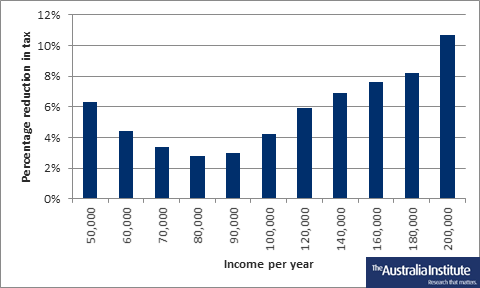
Proportional reduction in tax paid by income levels in 2024-25
If we look at various income levels up to $200,000 we can see that someone on $80,000 is getting a 3% reduction in the amount of tax they pay, while someone on $200,000 is getting an 11% reduction. That’s a four times bigger reduction.
This tax cut reduces how progressive our income tax system is:
Analysis from the ANU Centre for Social Research and Methods shows that - after the tax cut is fully implemented - the proportion of tax being paid by the top 20 per cent of households will be 3 per cent lower, while the proportion paid by the rest of the households will be 3 per cent higher.
Our progressive tax system means those on higher incomes, contribute a higher percentage of tax. But these tax cuts will now see someone on $41,000 a year, paying the same amount of tax as someone on $200,000 a year.
At a time when inequality is already rising in Australia, this will only make matters worse. The Gini Coefficient measure of inequality has gotten much worse over the last quarter of a century.

Rising Gini Coefficient indicates rising inequality.
The IMF and other economists have pointed out that rising inequality is bad for economic growth. Unequal societies grow at a slower rate than more equal ones. At a time when the government should be looking at policies to reduce inequality, they are instead introducing tax cuts that will make inequality worse.
How is the government justifying the tax cuts?
In selling their income tax cut plan, the government have claimed that these tax cuts are needed to compensate for bracket creep, grow the economy, and that it really does benefit middle income earners and is good for ‘aspiration’.
But is that really the case?
What is this ‘aspiration’ we keep hearing about?
In this context it means the government thinks low and middle income earners should support large tax cuts for high income earners, because they too hope to be high income earners one day.
So presumably, the government thinks that people should not only aspire to higher incomes, but they also want people to pay less tax when they achieve those higher incomes.
What about bracket creep?
In a progressive tax system, bracket creep is caused by rises in income that compensate for inflation - which pushes up your average rate of tax without increasing your purchasing power.
The government’s argument that high income earners need to be compensated for bracket creep is not supported by the data.
In fact, if we look at bracket creep since the introduction of the GST and we compare that with income tax cuts over the same period, we see that all income levels have been overcompensated for bracket creep caused by inflation. That is, tax cuts over the last 18 years have been larger than the impact of bracket creep.

The amount of money per year that different income groups are better off because income tax cuts have overcompensated for bracket creep
Not only has everyone already been overcompensated for bracket creep, but the high income earners (that group that benefits the most from the tax cut plan) have been overcompensated by the largest amount. Someone on a middle income of $55,000 is better off by about $1,500 per year but someone on $200,000 is better off by almost $11,000 per year.
Is the tax cut good for economic growth?
The government has also claimed that we need to cut income tax (or any taxes) to encourage economic growth. This argument is aimed at middle and low income earners who are largely missing out from this tax cut. It’s the government is saying: well, you might not be getting much of a tax cut but it will stimulate economic growth, and that will generate more employment and higher wages.
But there is no evidence to support this. In fact if we look at developed countries across the world we find the opposite.
Average incomes (GDP per person) are generally higher for countries that have higher taxation (tax to GDP ratio). The relationship is not a strong one but it certainly shows that the government’s claims that a low tax country grows faster is not supported by the data.
The figure below shows all the developed (OECD) countries as dots. They are positioned based on how high there average incomes are (GDP per person) and how large taxation is (tax to GDP). The black line is the trend line.
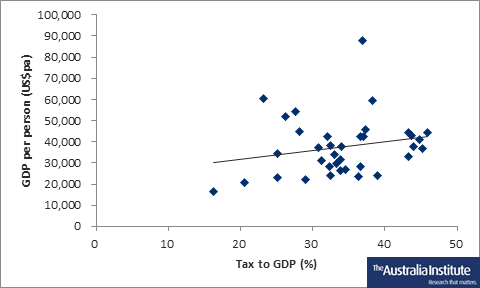
Developed countries GDP per person by tax to GDP. Source: Organisation for Economic Co-operation and Development (2018) OECD.Stat, https://stats.oecd.org/
But the government has been saying the tax cut is for middle Australia!
To prove that the income tax cuts are fair, the government has tried to redefine what middle income is by confusing middle income with full time average income.
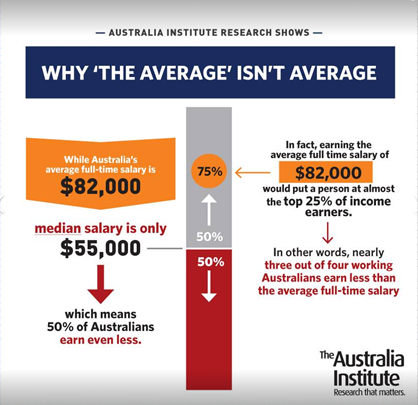
The median, or middle, income in Australia is $55,000 per year. This means that half of all workers earn more than $55,000 and half of all workers earn less than $55,000.
The full time average is $82,000 per year. The full time average excludes part time workers, and is also distorted by a small number of very high income earners pushing up the average. If you earned $82,000 then you would be in the top 25 per cent of income earners. In other words, only 25 per cent of workers would earn more than you while 75 per cent of workers would earn less than you.
So are these income tax cuts a good idea?
For the small number of people on high incomes, this tax cut will deliver — but at a cost to government services and social equality.
The government has bragged about how it will flatten the tax scales. A flatter tax system is by definition a less progressive system. Flatter income tax is code for big income tax cuts for the top end, and this tax cut delivers on that big time.
The tax cut will not improve economic growth or increase wages or employment. Bracket creep is a non-issue, particularly for high income earners that this tax cut is aimed at.
This truly is a tax cut for high income earners that will only entrench inequality in Australia further.
Between the Lines Newsletter
The biggest stories and the best analysis from the team at the Australia Institute, delivered to your inbox every fortnight.
You might also like
Youth Cultural Passes Could Revive Australian Live Music Industry
With ticket prices rising and the ongoing cost-of-living crisis, a youth cultural pass could make live music more accessible, providing young people with opportunities to support local artists and foster a lifelong love of the arts.
5 ways and 63 billion reasons to improve Australia’s tax system
With a federal election just around the corner, new analysis from The Australia Institute reveals 63 billion reasons why our next Parliament should improve the nation’s tax system.
The Liberal Party defies its own history on tax
For decades, the Liberal Party has prided itself on being the “party of lower taxes”.


